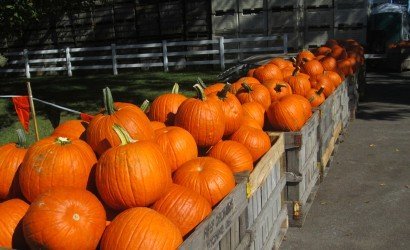There are 23 nature preserves in the state of Delaware. The Doe Bridge Nature Preserve, located almost directly behind the Stockley Center Memorial Park in Millsboro, encompasses more than 4,000 acres of land protected by the state. Less than eight miles away the one-and-only Native American museum in Delaware showcases the tools – arrowheads, stones, pottery, axe hammers, and more – that were once used to cultivate the local lands.
On my three mile walk through the woods of Millsboro, red, yellow, and orange leaves belonging to maple, ash, oak, and loblolly trees provided a beautify canopy overhead. I was entertained by the rhythmic sounds of crisp leaves crunching underfoot by my powerful and brisk strides through the sandy forest. I approached a bog of bright green moss and swamp cedar trees that offered a lovely contrast to the deep brown shades of fall that encompassed the area. This bog is known to produce the rare carnivorous pitcher plant that feeds on insects in the peat mat of the preserve. Unfortunately, there were no signs of this living ‘fly-trap’ during the cold November hike. It seems that by mid-November our local plant life is already preparing for cooler weather, rain, frost, and maybe even snow.
Only a short distance from the bog, the trees parted and a large vast clearing, filled with thigh-high grasses, sparked my imagination. I pictured Indians, rows of wigwams, and ceremonial dancing in the field framed by the deep blue sky. It was easy to imagine native people and dwellings on this land, untouched by modern development and void of the sounds produced by traffic and civilization.
The woods that I was stomping through were at one time, the perfect place for Eastern Shore Indians to hunt turkeys, rabbits, bear, ducks, geese, and deer. I carefully and quietly sat and watched six deer pull berries from branches and nestle in fallen leaves for a brief moment while on my walk. I caught myself crouched in the woods with my camera held steady just like our ancient ancestors may have done with a bow and arrow, aimed in the direction of the ruminant mammals. It wasn’t until the quick snap of my camera’s shutter spooked the creatures, that they pranced away gracefully.
The next time you’re outside, imagine looking at a tree branch and whittling the wooden stick for hours; sculpting it into a faultless bow. Then imagine finding a triangular-shaped stone and sharpening it into the perfect point for an arrow. How about using strong sea grasses to weave a sturdy basket to carry harvested corn, squash, or berries in? So much effort went into creating tools to hunt and harvest the land, forests, and meadows of the Eastern Shore.
The land of the Doe Bridge Nature Preserve, and the rest of the area surrounding the nearby Nanticoke River, was home to nearly 200 warriors. The Nanticoke Native Americans were known as the ‘tidewater people’ or ‘the people of the tidewaters’. It makes sense – they occupied areas along the water of the Chesapeake Bay and the Atlantic Ocean. The same area many of us call ‘home’ today.
At the Native American Museum, off of Route 24, there is a posted sign that reads,
“Keep up from all evil, for your is all that is – the earth and the sky: the streams, the hills, and the valleys, the starts, the moon, and the sun, and all that live and breathe. Wonderful, shining mighty Spirit!”
It’s an excerpt from the Indian’s Twenty-third Psalm, something the Nanticoke tribe followed religiously. The beautiful waterways, hills, valleys, and scenery of the Eastern Shore were greatly appreciated in 1608, the year that Native Americans were officially documented as inhabiting the area by Captain John Smith. Because it’s just as important to preserve our cultural history as our natural history, we have to think about the cultures that once called these 4,000 acres ‘home’. As an outdoor enthusiast, I believe that we should all appreciate everything that our land has to offer, and enjoy it, too.
Due to the sensitivity of its ecosystems, Doe Bridge is restricted to public access. The pathways through Doe Bridge are used as fire trails, access ways through thick brush in case of forest fires or other emergencies. They make for the perfect walking trails – if you stay on them. For more information on access to the nature preserve, contact the Delaware Department of Natural Resources and Environmental Control or for info about ancient inhabitants, the Nanticoke Indian Museum.
Several other local hiking spots are linked to history and are especially alluring during the fall. If you’d like to go hiking in a place rich with Native American history check out Assateague State Park, Lums Pond Park, Killens Pond, Trap Pond, or Indian River. Each of these state parks is open to the public and offer information about historic inhabitants.









